# Objective
- While building UI, it makes more sense for most nodes to have a `FocusPolicy` of `Pass`, so that user interaction can correctly bubble
- Only `ButtonBundle` blocks by default
This change means that for someone adding children to a button, it's not needed to change the focus policy of those children to `Pass` for the button to continue to work.
---
## Changelog
- `FocusPolicy` default has changed from `FocusPolicy::Block` to `FocusPolicy::Pass`
## Migration Guide
- `FocusPolicy` default has changed from `FocusPolicy::Block` to `FocusPolicy::Pass`
# Objective
- Fixes#7066
## Solution
- Split the ChangeDetection trait into ChangeDetection and ChangeDetectionMut
- Added Ref as equivalent to &T with change detection
---
## Changelog
- Support for Ref which allow inspecting change detection flags in an immutable way
## Migration Guide
- While bevy prelude includes both ChangeDetection and ChangeDetectionMut any code explicitly referencing ChangeDetection might need to be updated to ChangeDetectionMut or both. Specifically any reading logic requires ChangeDetection while writes requires ChangeDetectionMut.
use bevy_ecs::change_detection::DetectChanges -> use bevy_ecs::change_detection::{DetectChanges, DetectChangesMut}
- Previously Res had methods to access change detection `is_changed` and `is_added` those methods have been moved to the `DetectChanges` trait. If you are including bevy prelude you will have access to these types otherwise you will need to `use bevy_ecs::change_detection::DetectChanges` to continue using them.
# Objective
Speed up the render phase for rendering.
## Solution
- Follow up #6988 and make the internals of atomic IDs `NonZeroU32`. This niches the `Option`s of the IDs in draw state, which reduces the size and branching behavior when evaluating for equality.
- Require `&RenderDevice` to get the device's `Limits` when initializing a `TrackedRenderPass` to preallocate the bind groups and vertex buffer state in `DrawState`, this removes the branch on needing to resize those `Vec`s.
## Performance
This produces a similar speed up akin to that of #6885. This shows an approximate 6% speed up in `main_opaque_pass_3d` on `many_foxes` (408.79 us -> 388us). This should be orthogonal to the gains seen there.
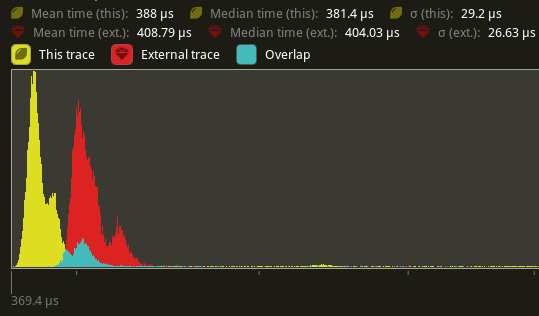
---
## Changelog
Added: `RenderContext::begin_tracked_render_pass`.
Changed: `TrackedRenderPass` now requires a `&RenderDevice` on construction.
Removed: `bevy_render::render_phase::DrawState`. It was not usable in any form outside of `bevy_render`.
## Migration Guide
TODO
# Objective
- Fixes#5529
## Solution
- Add assosciated constants named DEFAULT to as many types as possible
- Add const to as many methods in bevy_ui as possible
I have not applied the same treatment to the bundles in bevy_ui as it would require going into other bevy crates to implement const defaults for structs in bevy_text or relies on UiImage which calls HandleUntyped.typed() which isn't const safe.
Alternatively the defaults could relatively easily be turned into a macro to regain some of the readability and conciseness at the cost of explicitness.
Such a macro that partially implements this exists as a crate here: [const-default](https://docs.rs/const-default/latest/const_default/derive.ConstDefault.html) but does not support enums.
Let me know if there's anything I've missed or if I should push further into other crates.
Co-authored-by: Carter Anderson <mcanders1@gmail.com>
# Objective
Speed up the render phase of rendering. Simplify the trait structure for render commands.
## Solution
- Merge `EntityPhaseItem` into `PhaseItem` (`EntityPhaseItem::entity` -> `PhaseItem::entity`)
- Merge `EntityRenderCommand` into `RenderCommand`.
- Add two associated types to `RenderCommand`: `RenderCommand::ViewWorldQuery` and `RenderCommand::WorldQuery`.
- Use the new associated types to construct two `QueryStates`s for `RenderCommandState`.
- Hoist any `SQuery<T>` fetches in `EntityRenderCommand`s into the aformentioned two queries. Batch fetch them all at once.
## Performance
`main_opaque_pass_3d` is slightly faster on `many_foxes` (427.52us -> 401.15us)
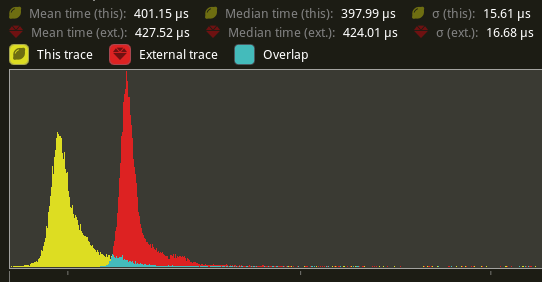
The shadow pass node is also slightly faster (344.52 -> 338.24us)
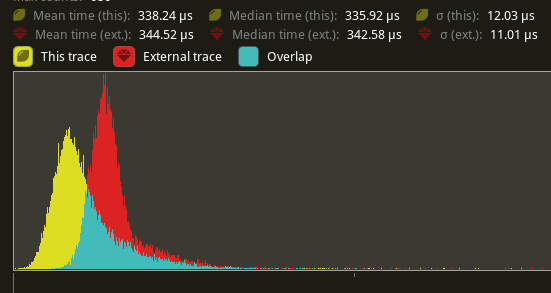
## Future Work
- Can we hoist the view level queries out of the core loop?
---
## Changelog
Added: `PhaseItem::entity`
Added: `RenderCommand::ViewWorldQuery` associated type.
Added: `RenderCommand::ItemorldQuery` associated type.
Added: `Draw<T>::prepare` optional trait function.
Removed: `EntityPhaseItem` trait
## Migration Guide
TODO
# Objective
- The recently merged PR #7013 does not allow multiple `RenderPhase`s to share the same `RenderPass`.
- Due to the introduced overhead we want to minimize the number of `RenderPass`es recorded during each frame.
## Solution
- Take a constructed `TrackedRenderPass` instead of a `RenderPassDiscriptor` as a parameter to the `RenderPhase::render` method.
---
## Changelog
To enable multiple `RenderPhases` to share the same `TrackedRenderPass`,
the `RenderPhase::render` signature has changed.
```rust
pub fn render<'w>(
&self,
render_pass: &mut TrackedRenderPass<'w>,
world: &'w World,
view: Entity)
```
Co-authored-by: Kurt Kühnert <51823519+kurtkuehnert@users.noreply.github.com>
# Objective
All `RenderPhases` follow the same render procedure.
The same code is duplicated multiple times across the codebase.
## Solution
I simply extracted this code into a method on the `RenderPhase`.
This avoids code duplication and makes setting up new `RenderPhases` easier.
---
## Changelog
### Changed
You can now set up the rendering code of a `RenderPhase` directly using the `RenderPhase::render` method, instead of implementing it manually in your render graph node.
# Objective
Upgrade to Taffy 0.2
## Solution
Do it
## Changelog
Upgraded to Taffy 0.2, improving UI layout performance significantly and adding the flexbox `gap` property and `AlignContent::SpaceEvenly`.
## Notes
`many_buttons` is 8% faster! speed improvements for more highly nested UIs will be much more dramatic. Great work, Team Taffy.
The Camera link in the UiCameraConfig was not rendered properly by the documentation.
# Objective
- In the UiCameraConfig page (https://docs.rs/bevy/latest/bevy/prelude/struct.UiCameraConfig.html), a link to the Camera page (https://docs.rs/bevy/latest/bevy/render/camera/struct.Camera.html) is broken.
## Solution
- It seems that when using URL fragment specifiers, backtick should not be used. It might be an issue of rust itself. Replacing the URL fragment specifier `[`Camera`]: bevy_render:📷:Camera` with `[Camera]: bevy_render:📷:Camera` solves this.
## Objective
Bevy UI uses a `MeasureFunc` that preserves the aspect ratio of text, not just images. This means that the extent of flex-items containing text may be calculated incorrectly depending on the ratio of the text size compared to the size of its containing node.
Fixes#6748
Related to #6724
with Bevy 0.9:
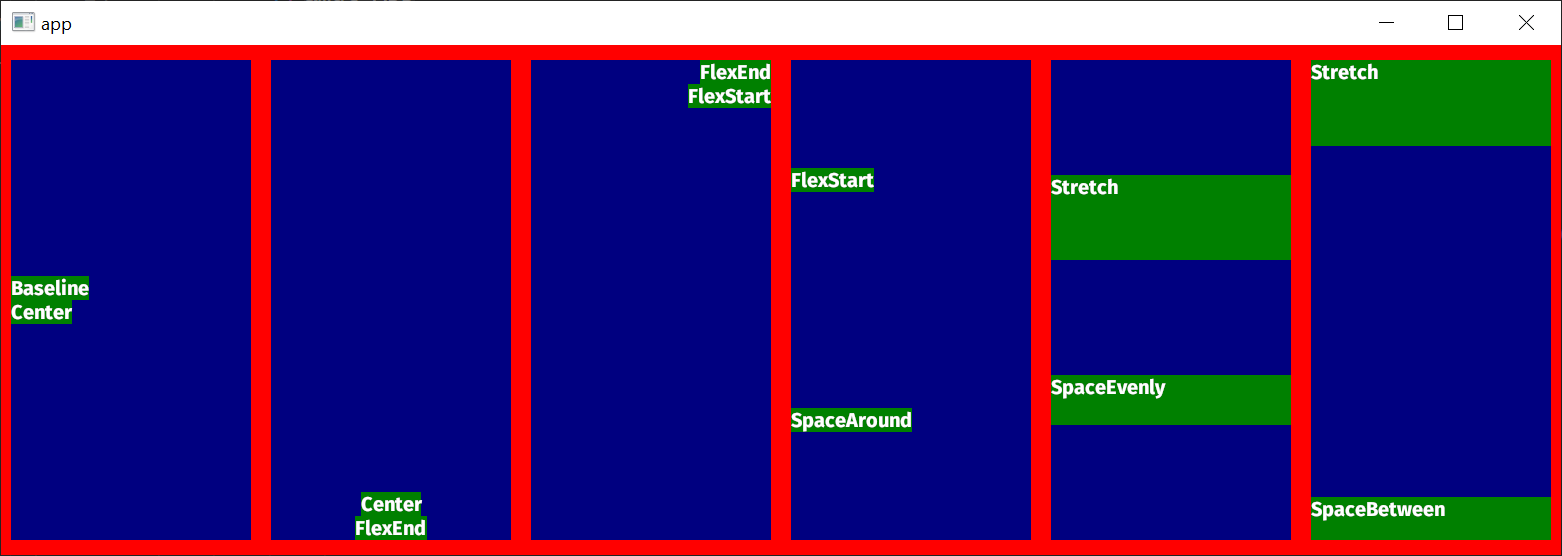
with this PR (accurately matching the behavior of Flexbox):
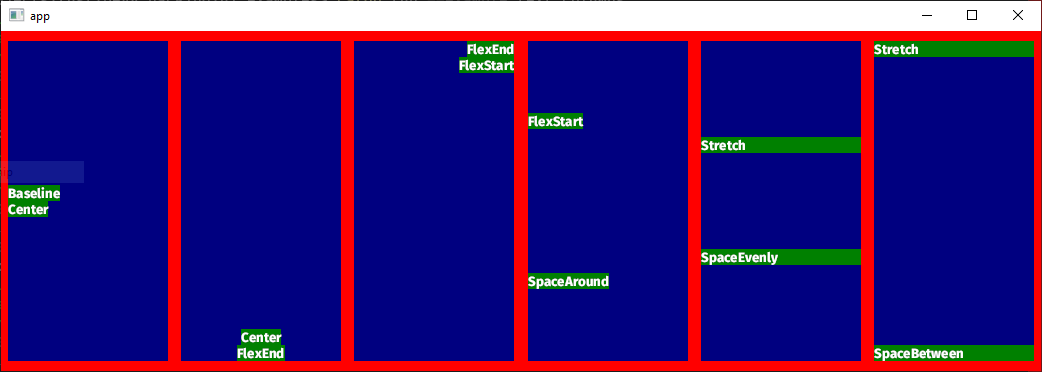
## Solution
Only perform the aspect ratio calculations if the uinode contains an image.
## Changelog
* Added a field `preserve_aspect_ratio` to `CalculatedSize`
* The `MeasureFunc` only preserves the aspect ratio when `preserve_aspect_ratio` is true.
* `update_image_calculated_size_system` sets `preserve_aspect_ratio` to true for nodes with images.
# Objective
Change detection can be spuriously triggered by setting a field to the same value as before. As a result, a common pattern is to write:
```rust
if *foo != value {
*foo = value;
}
```
This is confusing to read, and heavy on boilerplate.
Adopted from #5373, but untangled and rebased to current `bevy/main`.
## Solution
1. Add a method to the `DetectChanges` trait that implements this boilerplate when the appropriate trait bounds are met.
2. Document this minor footgun, and point users to it.
## Changelog
* added the `set_if_neq` method to avoid triggering change detection when the new and previous values are equal. This will work on both components and resources.
## Migration Guide
If you are manually checking if a component or resource's value is equal to its new value before setting it to avoid triggering change detection, migrate to the clearer and more convenient `set_if_neq` method.
## Context
Related to #2363 as it avoids triggering change detection, but not a complete solution (as it still requires triggering it when real changes are made).
Co-authored-by: Zoey <Dessix@Dessix.net>
# Objective
- Every usage of `DrawFunctionsInternals::get_id()` was followed by a `.unwrap()`. which just adds boilerplate.
## Solution
- Introduce a fallible version of `DrawFunctionsInternals::get_id()` and use it where possible.
- I also took the opportunity to improve the error message a little in the case where it fails.
---
## Changelog
- Added `DrawFunctionsInternals::id()`
# Objective
Fixes#6642
In a way that doesn't create any breaking changes, as a possible way to fix the above in a patch release.
## Solution
Don't actually remove font atlases when `max_font_atlases` is exceeded. Add a warning instead.
Keep `TextError::ExceedMaxTextAtlases` and `TextSettings` as-is so we don't break anything.
This is a bit of a cop-out, but the problems revealed by #6642 seem very challenging to fix properly.
Maybe follow up later with something more like https://github.com/rparrett/bevy/commits/remove-max-font-atlases later, if this is the direction we want to go.
## Note
See previous attempt at a "simple fix" that only solved some of the issues: #6666
# Objective
`add_node_edge` and `add_slot_edge` are fallible methods, but are always used with `.unwrap()`.
`input_node` is often unwrapped as well.
This points to having an infallible behaviour as default, with an alternative fallible variant if needed.
Improves readability and ergonomics.
## Solution
- Change `add_node_edge` and `add_slot_edge` to panic on error.
- Change `input_node` to panic on `None`.
- Add `try_add_node_edge` and `try_add_slot_edge` in case fallible methods are needed.
- Add `get_input_node` to still be able to get an `Option`.
---
## Changelog
### Added
- `try_add_node_edge`
- `try_add_slot_edge`
- `get_input_node`
### Changed
- `add_node_edge` is now infallible (panics on error)
- `add_slot_edge` is now infallible (panics on error)
- `input_node` now panics on `None`
## Migration Guide
Remove `.unwrap()` from `add_node_edge` and `add_slot_edge`.
For cases where the error was handled, use `try_add_node_edge` and `try_add_slot_edge` instead.
Remove `.unwrap()` from `input_node`.
For cases where the option was handled, use `get_input_node` instead.
Co-authored-by: Torstein Grindvik <52322338+torsteingrindvik@users.noreply.github.com>
# Objective
Allow more use cases where the user may benefit from both `ExtractComponentPlugin` _and_ `UniformComponentPlugin`.
## Solution
Add an associated type to `ExtractComponent` in order to allow specifying the output component (or bundle).
Make `extract_component` return an `Option<_>` such that components can be extracted only when needed.
What problem does this solve?
`ExtractComponentPlugin` allows extracting components, but currently the output type is the same as the input.
This means that use cases such as having a settings struct which turns into a uniform is awkward.
For example we might have:
```rust
struct MyStruct {
enabled: bool,
val: f32
}
struct MyStructUniform {
val: f32
}
```
With the new approach, we can extract `MyStruct` only when it is enabled, and turn it into its related uniform.
This chains well with `UniformComponentPlugin`.
The user may then:
```rust
app.add_plugin(ExtractComponentPlugin::<MyStruct>::default());
app.add_plugin(UniformComponentPlugin::<MyStructUniform>::default());
```
This then saves the user a fair amount of boilerplate.
## Changelog
### Changed
- `ExtractComponent` can specify output type, and outputting is optional.
Co-authored-by: Torstein Grindvik <52322338+torsteingrindvik@users.noreply.github.com>
# Objective
Delete `ImageMode`. It doesn't do anything except mislead people into thinking it controls the aspect ratio of images somehow.
Fixes#3933 and #6637
## Solution
Delete `ImageMode`
## Changelog
Removes the `ImageMode` enum.
Removes the `image_mode` field from `ImageBundle`
Removes the `With<ImageMode>` query filter from `image_node_system`
Renames `image_node_system` to` update_image_calculated_size_system`
# Objective
Fixes#6594
## Solution
- `New` function for `Size` is now a `const` function :)
## Changelog
- `New` function for `Size` is now a `const` function
## Migration Guide
- Nothing has been changed
# Objective
Fixes #3225, Allow for flippable UI Images
## Solution
Add flip_x and flip_y fields to UiImage, and swap the UV coordinates accordingly in ui_prepare_nodes.
## Changelog
* Changes UiImage to a struct with texture, flip_x, and flip_y fields.
* Adds flip_x and flip_y fields to ExtractedUiNode.
* Changes extract_uinodes to extract the flip_x and flip_y values from UiImage.
* Changes prepare_uinodes to swap the UV coordinates as required.
* Changes UiImage derefs to texture field accesses.
This reverts commit 8429b6d6ca as discussed in #6522.
I tested that the game_menu example works as it should.
Co-authored-by: devil-ira <justthecooldude@gmail.com>
# Objective
`NodeBundle` contains an `image` field, which can be misleading, because if you do supply an image there, nothing will be shown to screen. You need to use an `ImageBundle` instead.
## Solution
* `image` (`UiImage`) field is removed from `NodeBundle`,
* extraction stage queries now make an optional query for `UiImage`, if one is not found, use the image handle that is used as a default by `UiImage`: c019a60b39/crates/bevy_ui/src/ui_node.rs (L464)
* touching up docs for `NodeBundle` to help guide what `NodeBundle` should be used for
* renamed `entity.rs` to `node_bundle.rs` as that gives more of a hint regarding the module's purpose
* separating `camera_config` stuff from the pre-made UI node bundles so that `node_bundle.rs` makes more sense as a module name.
# Objective
Bevy UI (and third party plugins) currently have no good way to position themselves after all post processing effects. They currently use the tonemapping node, but this is not adequate if there is anything after tonemapping (such as FXAA).
## Solution
Add a logical `END_MAIN_PASS_POST_PROCESSING` RenderGraph node that main pass post processing effects position themselves before, and things like UIs can position themselves after.
# Objective
The UI pass in HDR breaks currently because the color attachment format does not match the HDR ViewTarget.
## Solution
Specialize the UI pipeline on "hdr-ness" and select the appropriate format (like we do in the other built in pipelines).
# Objective
Replace `WorldQueryGats` trait with actual gats
## Solution
Replace `WorldQueryGats` trait with actual gats
---
## Changelog
- Replaced `WorldQueryGats` trait with actual gats
## Migration Guide
- Replace usage of `WorldQueryGats` assoc types with the actual gats on `WorldQuery` trait
# Objective
Add consistent UI rendering and interaction where deep nodes inside two different hierarchies will never render on top of one-another by default and offer an escape hatch (z-index) for nodes to change their depth.
## The problem with current implementation
The current implementation of UI rendering is broken in that regard, mainly because [it sets the Z value of the `Transform` component based on a "global Z" space](https://github.com/bevyengine/bevy/blob/main/crates/bevy_ui/src/update.rs#L43) shared by all nodes in the UI. This doesn't account for the fact that each node's final `GlobalTransform` value will be relative to its parent. This effectively makes the depth unpredictable when two deep trees are rendered on top of one-another.
At the moment, it's also up to each part of the UI code to sort all of the UI nodes. The solution that's offered here does the full sorting of UI node entities once and offers the result through a resource so that all systems can use it.
## Solution
### New ZIndex component
This adds a new optional `ZIndex` enum component for nodes which offers two mechanism:
- `ZIndex::Local(i32)`: Overrides the depth of the node relative to its siblings.
- `ZIndex::Global(i32)`: Overrides the depth of the node relative to the UI root. This basically allows any node in the tree to "escape" the parent and be ordered relative to the entire UI.
Note that in the current implementation, omitting `ZIndex` on a node has the same result as adding `ZIndex::Local(0)`. Additionally, the "global" stacking context is essentially a way to add your node to the root stacking context, so using `ZIndex::Local(n)` on a root node (one without parent) will share that space with all nodes using `Index::Global(n)`.
### New UiStack resource
This adds a new `UiStack` resource which is calculated from both hierarchy and `ZIndex` during UI update and contains a vector of all node entities in the UI, ordered by depth (from farthest from camera to closest). This is exposed publicly by the bevy_ui crate with the hope that it can be used for consistent ordering and to reduce the amount of sorting that needs to be done by UI systems (i.e. instead of sorting everything by `global_transform.z` in every system, this array can be iterated over).
### New z_index example
This also adds a new z_index example that showcases the new `ZIndex` component. It's also a good general demo of the new UI stack system, because making this kind of UI was very broken with the old system (e.g. nodes would render on top of each other, not respecting hierarchy or insert order at all).
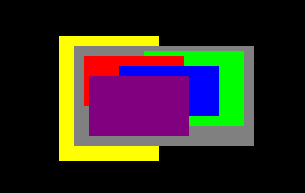
---
## Changelog
- Added the `ZIndex` component to bevy_ui.
- Added the `UiStack` resource to bevy_ui, and added implementation in a new `stack.rs` module.
- Removed the previous Z updating system from bevy_ui, because it was replaced with the above.
- Changed bevy_ui rendering to use UiStack instead of z ordering.
- Changed bevy_ui focus/interaction system to use UiStack instead of z ordering.
- Added a new z_index example.
## ZIndex demo
Here's a demo I wrote to test these features
https://user-images.githubusercontent.com/1060971/188329295-d7beebd6-9aee-43ab-821e-d437df5dbe8a.mp4
Co-authored-by: Carter Anderson <mcanders1@gmail.com>
This reverts commit 53d387f340.
# Objective
Reverts #6448. This didn't have the intended effect: we're now getting bevy::prelude shown in the docs again.
Co-authored-by: Alejandro Pascual <alejandro.pascual.pozo@gmail.com>
# Objective
- Right now re-exports are completely hidden in prelude docs.
- Fixes#6433
## Solution
- We could show the re-exports without inlining their documentation.
# Objective
Bevy still has many instances of using single-tuples `(T,)` to create a bundle. Due to #2975, this is no longer necessary.
## Solution
Search for regex `\(.+\s*,\)`. This should have found every instance.
# Objective
- fix new clippy lints before they get stable and break CI
## Solution
- run `clippy --fix` to auto-fix machine-applicable lints
- silence `clippy::should_implement_trait` for `fn HandleId::default<T: Asset>`
## Changes
- always prefer `format!("{inline}")` over `format!("{}", not_inline)`
- prefer `Box::default` (or `Box::<T>::default` if necessary) over `Box::new(T::default())`
# Objective
Bevy's internal plugins have lots of execution-order ambiguities, which makes the ambiguity detection tool very noisy for our users.
## Solution
Silence every last ambiguity that can currently be resolved.
Each time an ambiguity is silenced, it is accompanied by a comment describing why it is correct. This description should be based on the public API of the respective systems. Thus, I have added documentation to some systems describing how they use some resources.
# Future work
Some ambiguities remain, due to issues out of scope for this PR.
* The ambiguity checker does not respect `Without<>` filters, leading to false positives.
* Ambiguities between `bevy_ui` and `bevy_animation` cannot be resolved, since neither crate knows that the other exists. We will need a general solution to this problem.
Attempt to make features like bloom https://github.com/bevyengine/bevy/pull/2876 easier to implement.
**This PR:**
- Moves the tonemapping from `pbr.wgsl` into a separate pass
- also add a separate upscaling pass after the tonemapping which writes to the swap chain (enables resolution-independant rendering and post-processing after tonemapping)
- adds a `hdr` bool to the camera which controls whether the pbr and sprite shaders render into a `Rgba16Float` texture
**Open questions:**
- ~should the 2d graph work the same as the 3d one?~ it is the same now
- ~The current solution is a bit inflexible because while you can add a post processing pass that writes to e.g. the `hdr_texture`, you can't write to a separate `user_postprocess_texture` while reading the `hdr_texture` and tell the tone mapping pass to read from the `user_postprocess_texture` instead. If the tonemapping and upscaling render graph nodes were to take in a `TextureView` instead of the view entity this would almost work, but the bind groups for their respective input textures are already created in the `Queue` render stage in the hardcoded order.~ solved by creating bind groups in render node
**New render graph:**
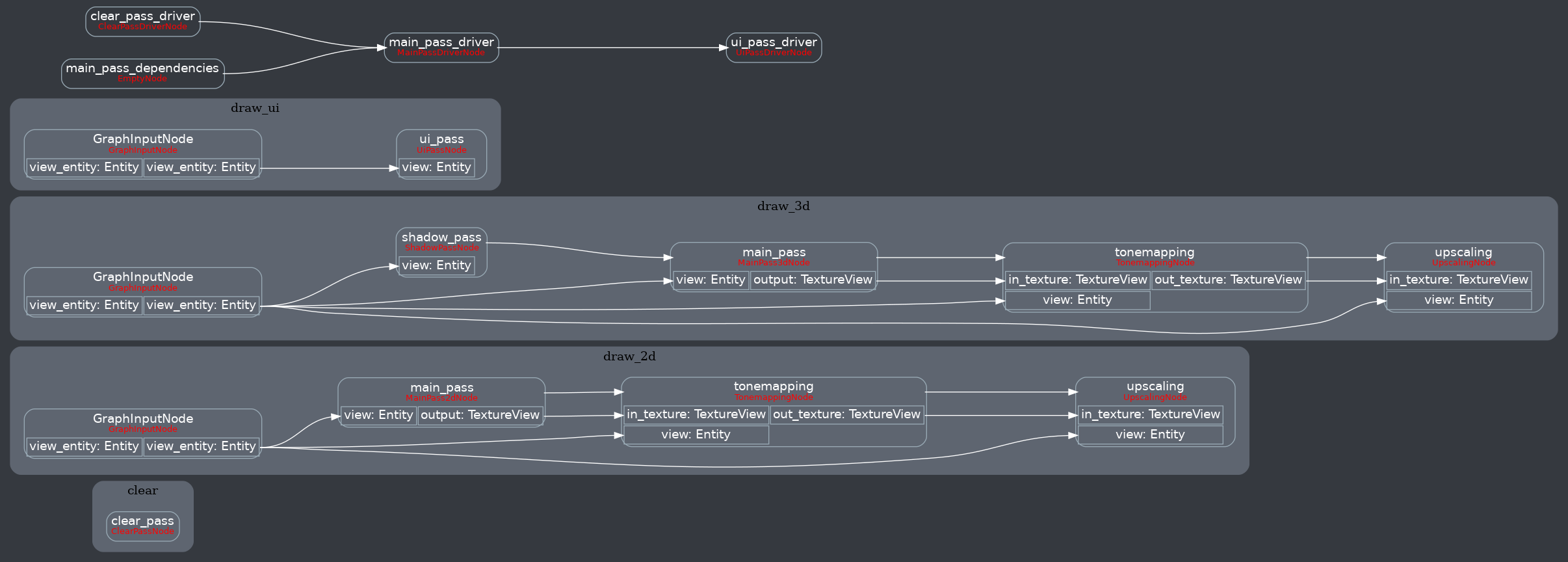
<details>
<summary>Before</summary>
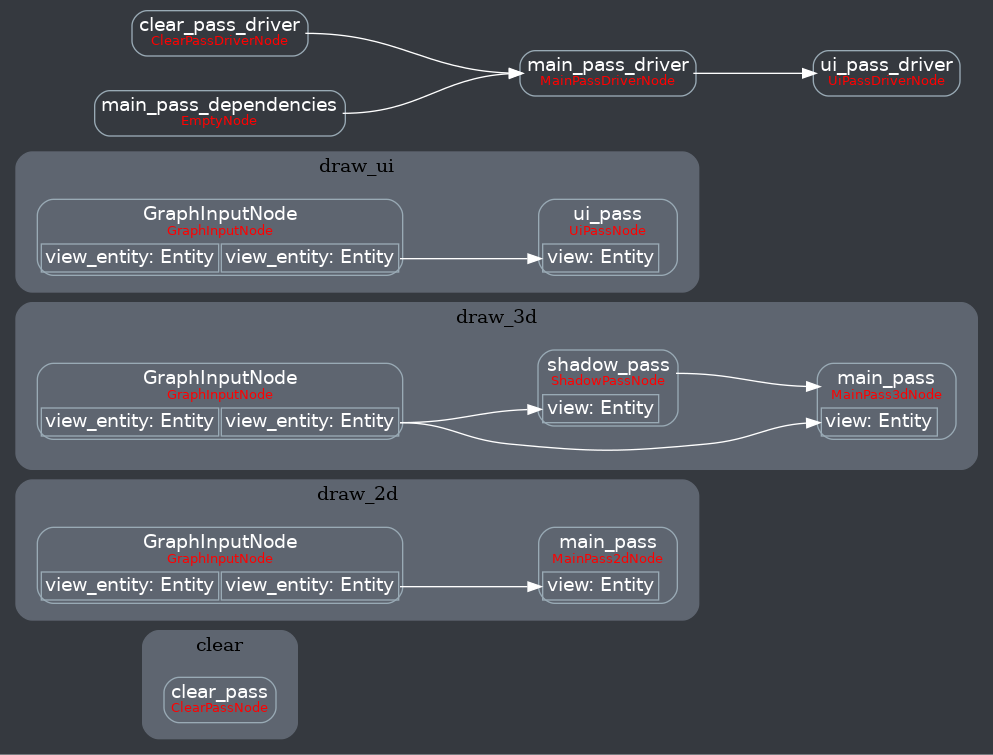
</details>
Co-authored-by: Carter Anderson <mcanders1@gmail.com>
# Objective
- Proactive changing of code to comply with warnings generated by beta of rustlang version of cargo clippy.
## Solution
- Code changed as recommended by `rustup update`, `rustup default beta`, `cargo run -p ci -- clippy`.
- Tested using `beta` and `stable`. No clippy warnings in either after changes made.
---
## Changelog
- Warnings fixed were: `clippy::explicit-auto-deref` (present in 11 files), `clippy::needless-borrow` (present in 2 files), and `clippy::only-used-in-recursion` (only 1 file).
# Objective
- Clipping (visible in the UI example with text scrolling) is funky
- Fixes#6287
## Solution
- Fix UV calculation:
- correct order for values (issue introduced in #6000)
- add the `y` values instead of subtracting them now that vertical order is reversed
- take scale factor into account (bug already present before reversing the order)
- While around clipping, I changed clip to only mutate when changed
No more funkiness! 😞
<img width="696" alt="Screenshot 2022-10-23 at 22 44 18" src="https://user-images.githubusercontent.com/8672791/197417721-30ad4150-5264-427f-ac82-e5265c1fb3a9.png">
# Objective
Adds a better interface for performing mathematical operations with UI unit `Val`. Fixes#6080.
## Solution
- Added `try_add` and `try_sub` methods to Val.
- Removed the `Add` and `AddAssign` impls for `Val` that introduced unintuitive and bug-prone behaviour.
- As a consequence of the prior, ~~changed the `Add` and `Sub` impls for the `Size` struct to take a `(Val, Val)` instead of `Vec2`~~ deleted the `Add` and `Sub` impls for the `Size` struct
- Added a `From<(Val, Val)>` impl for the `Size` struct
- Added `evaluate(size: f32)` method that converts from `Val::Percent` to `Val::Px`.
- Added `try_add_with_size` and `try_sub_with_size` methods to `Val`, which evaluate `Val::Percent` values into `Val::Px` values before adding.
---
## Migration Guide
Instead of using the + and - operators, perform calculations on `Val`s using the new `try_add` and `try_sub` methods. Multiplication and division remained unchanged. Also, when adding or subtracting from `Size`, ~~use a `Val` tuple instead of `Vec2`~~ perform the addition on `width` and `height` separately.
Co-authored-by: Dawid Piotrowski <41804418+Pietrek14@users.noreply.github.com>
# Objective
Fixes#6272
## Solution
Revert to old way of positioning text for Text2D rendered text.
Co-authored-by: Michel van der Hulst <hulstmichel@gmail.com>
# Objective
Fixes#5820
## Solution
Change field name and documentation from `bevy::ui::Node` struct
---
## Changelog
`bevy::ui::Node` `size` field has renamed to `calculated_size`
## Migration Guide
All references to the old `size` name has been changed, to access `bevy::ui::Node` `size` field use `calculated_size`
# Objective
There is no Srgb support on some GPU and display protocols with `winit` (for example, Nvidia's GPUs with Wayland). Thus `TextureFormat::bevy_default()` which returns `Rgba8UnormSrgb` or `Bgra8UnormSrgb` will cause panics on such platforms. This patch will resolve this problem. Fix https://github.com/bevyengine/bevy/issues/3897.
## Solution
Make `initialize_renderer` expose `wgpu::Adapter` and `first_available_texture_format`, use the `first_available_texture_format` by default.
## Changelog
* Fixed https://github.com/bevyengine/bevy/issues/3897.
# Objective
Closes#6202.
The default background color for `NodeBundle` is currently white.
However, it's very rare that you actually want a white background color.
Instead, you often want a background color specific to the style of your game or a transparent background (e.g. for UI layout nodes).
## Solution
`Default` is not derived for `NodeBundle` anymore, but explicitly specified.
The default background color is now transparent (`Color::NONE.into()`) as this is the most common use-case, is familiar from the web and makes specifying a layout for your UI less tedious.
---
## Changelog
- Changed the default `NodeBundle.background_color` to be transparent (`Color::NONE.into()`).
## Migration Guide
If you want a `NodeBundle` with a white background color, you must explicitly specify it:
Before:
```rust
let node = NodeBundle {
..default()
}
```
After:
```rust
let node = NodeBundle {
background_color: Color::WHITE.into(),
..default()
}
```
# Objective
Fixes#6010
## Solution
As discussed in #6010, this makes it so the `Children` component is removed from the entity whenever all of its children are removed. The behavior is now consistent between all of the commands that may remove children from a parent, and this is tested via two new test functions (one for world functions and one for commands).
Documentation was also added to `insert_children`, `push_children`, `add_child` and `remove_children` commands to make this behavior clearer for users.
## Changelog
- Fixed `Children` component not getting removed from entity when all its children are moved to a new parent.
## Migration Guide
- Queries with `Changed<Children>` will no longer match entities that had all of their children removed using `remove_children`.
- `RemovedComponents<Children>` will now contain entities that had all of their children remove using `remove_children`.
# Objective
Often one wants to create a `UiRect` with a value only specifying a single field. These ways are already available, but not the most ergonomic:
```rust
UiRect::new(Val::Undefined, Val::Undefined, Val::Percent(25.0), Val::Undefined)
```
```rust
UiRect {
top: Val::Percent(25.0),
..default()
}
```
## Solution
Introduce 6 new constructors:
- `horizontal`
- `vertical`
- `left`
- `right`
- `top`
- `bottom`
So the above code can be written instead as:
```rust
UiRect::top(Val::Percent(25.0))
```
This solution is similar to the style fields `margin-left`, `padding-top`, etc. that you would see in CSS, from which bevy's UI has other inspiration. Therefore, it should still feel intuitive to users coming from CSS.
---
## Changelog
### Added
- Additional constructors for `UiRect` to specify values for specific fields
# Objective
The [Stageless RFC](https://github.com/bevyengine/rfcs/pull/45) involves allowing exclusive systems to be referenced and ordered relative to parallel systems. We've agreed that unifying systems under `System` is the right move.
This is an alternative to #4166 (see rationale in the comments I left there). Note that this builds on the learnings established there (and borrows some patterns).
## Solution
This unifies parallel and exclusive systems under the shared `System` trait, removing the old `ExclusiveSystem` trait / impls. This is accomplished by adding a new `ExclusiveFunctionSystem` impl similar to `FunctionSystem`. It is backed by `ExclusiveSystemParam`, which is similar to `SystemParam`. There is a new flattened out SystemContainer api (which cuts out a lot of trait and type complexity).
This means you can remove all cases of `exclusive_system()`:
```rust
// before
commands.add_system(some_system.exclusive_system());
// after
commands.add_system(some_system);
```
I've also implemented `ExclusiveSystemParam` for `&mut QueryState` and `&mut SystemState`, which makes this possible in exclusive systems:
```rust
fn some_exclusive_system(
world: &mut World,
transforms: &mut QueryState<&Transform>,
state: &mut SystemState<(Res<Time>, Query<&Player>)>,
) {
for transform in transforms.iter(world) {
println!("{transform:?}");
}
let (time, players) = state.get(world);
for player in players.iter() {
println!("{player:?}");
}
}
```
Note that "exclusive function systems" assume `&mut World` is present (and the first param). I think this is a fair assumption, given that the presence of `&mut World` is what defines the need for an exclusive system.
I added some targeted SystemParam `static` constraints, which removed the need for this:
``` rust
fn some_exclusive_system(state: &mut SystemState<(Res<'static, Time>, Query<&'static Player>)>) {}
```
## Related
- #2923
- #3001
- #3946
## Changelog
- `ExclusiveSystem` trait (and implementations) has been removed in favor of sharing the `System` trait.
- `ExclusiveFunctionSystem` and `ExclusiveSystemParam` were added, enabling flexible exclusive function systems
- `&mut SystemState` and `&mut QueryState` now implement `ExclusiveSystemParam`
- Exclusive and parallel System configuration is now done via a unified `SystemDescriptor`, `IntoSystemDescriptor`, and `SystemContainer` api.
## Migration Guide
Calling `.exclusive_system()` is no longer required (or supported) for converting exclusive system functions to exclusive systems:
```rust
// Old (0.8)
app.add_system(some_exclusive_system.exclusive_system());
// New (0.9)
app.add_system(some_exclusive_system);
```
Converting "normal" parallel systems to exclusive systems is done by calling the exclusive ordering apis:
```rust
// Old (0.8)
app.add_system(some_system.exclusive_system().at_end());
// New (0.9)
app.add_system(some_system.at_end());
```
Query state in exclusive systems can now be cached via ExclusiveSystemParams, which should be preferred for clarity and performance reasons:
```rust
// Old (0.8)
fn some_system(world: &mut World) {
let mut transforms = world.query::<&Transform>();
for transform in transforms.iter(world) {
}
}
// New (0.9)
fn some_system(world: &mut World, transforms: &mut QueryState<&Transform>) {
for transform in transforms.iter(world) {
}
}
```
# Objective
I was working with the TextBundle component bundle because I wanted to change the position of the text that the bundle was holding. I used the transform field on the TextBundle at first because that is normally what controls the position of sprites in Bevy and that's what I was used to working with.
But the actual way to change the position of text inside of a TextBundle is to use the Style's position field, not the TextBundle's transform field.
Anecdotally, it was mentioned on the discord that other users have had this issue too.
## Solution
I added a small doc comment to the TextBundle's transform telling users not to use it to set the position of text. And since this issue applies to the other UI bundles, I added comments there as well!